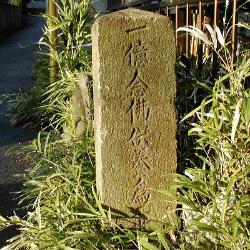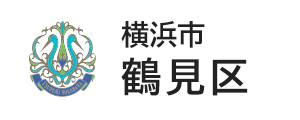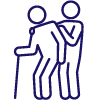- Yokohama-shi Top Page
- Tsurumi Ward Top Page
- Introduction of the ward
- Overview of Tsurumi Ward
- History of Tsurumi Ward
- 20th: Awashima-sama and Awashima faith spoken by signposts
Here's the text.
20th: Awashima-sama and Awashima faith spoken by signposts
Last Updated July 9, 2024

Stone pagoda
There is a small temple called Gyojoan along the old road of 4-chome Kamisueyoshi, Tsurumi-ku.
Rather than a temple, if there is no graveyard in the back, no one will notice a temple. At the entrance of this Gyohashi-an, there is a stone pagoda facing the old road called "2nd Anraku for the memorial service of 100 million Buddhas." It is a square tower with a height of 87 cm and a width of 25 cm, and the tower body is about to fall down. On the right side, there is a signpost saying "Right Awashima Road, Left Tomura Fudo Road". (Back side) September (1753)
Gyojo-an was called Dainichiyama Gyojo-in in the old days, and was a temple of the Jodo sect that was said to be the origin of Seiei Keikai in 1691. After that, it declined and became uninhabited, and was revived by Hosenji No. 10 of the Shimosueyoshi Soto sect, and changed to its current religion.
Since then, it has become the Osu-ji temple of Honji Hosenji. In the Jodo sect era, it was a nunji temple, and in the cemetery, there are tombs of Keikai Nun (September 21, 1698) and other nuns. Gyojo-in was changed to Gyojo-an in the Meiji era, and was inhabited by nuns.
1890, Nov. 5, 1890
Katsura Hotokurin Nun Class, February 9, 1906
Shindake Shuzen Nunity, January 30, 1940
By the way, this signpost was originally located on the west side of Sueyoshi Bridge, and it was said that he moved to his current location in the early Showa era. At the signpost, you can see Kobayashi Uesueyoshimura and the owner's name, but Kobayashi's surname is an old house that is common in Kajiyama. In addition, the Kajiyama area has been a popular place for women's memorial Buddha since ancient times.
In front of Mr. Chuichi Kobayashi of Kajiyama 2-chome, there is a memorial service tower built in Kanbun 13 (1673), and all 14 owners are housewives, of which 11 are Kobayashi's last name. All of them are "Kobayashi--the inner court." Kobayashi, the founder of the signpost on the side of Sueyoshi Bridge, may have had several women's memorial Buddha lectures. Sueyoshi Bridge is the eastern edge of the Kajiyama area. It is said that most of the women's memorial Buddha lectures were organized in relation to the neighborhood, mainly at nearby Jodo sect temples, etc., and the women's memorial Buddha lecture at Kajiyama seems to have a relationship with Gyojoan. Awashima-sama has a common religion of women as a god of women, and the construction of this signpost can be considered whether it is related to the women's memorial Buddha lecture.
If you go along the bank of the Tsurumi River toward Futoo, the end of Okuma Town is Awashima Shrine in Orimotocho. Once upon a time, a visitor to Awashima Shrine, who came from Edo, looked at the signpost at the base of the bridge, took a break, and rushed the road.
Awashima Shrine (now Orihonmachi, Kohoku-ku) is said to have been widely revered by the common people as a god of women's religion during the Edo period. In the "Edo Famous Zoukai", "Tirteen to the left from Awashima Shrine and Sagami Kaido Okuma Village, four towns are located in Orimoto Village, worshiped by Shinto Unji. The festival is March 3rd, the fair is the first day of each month and the thirteenth day, and the god of the festival is the name of Shohiko Namei (Sukuna Hikona Mikoto) and the two seats of Empress Shinko, and the beginning of the recommendation is unknown. " The Kata Shrine in Wakayama in Kishu is said to be its headquarters, where red paper dolls are still distributed as a talisman for women.
It is said that there are psychic diseases, children, and safe birth prayers.
Since the middle of the early modern era, temple tours have been actively conducted among the common people for the purpose of worshiping sacred sites in various places. It is also a feature of this era that women's memorial Buddha lectures were separated from the constraints of the life of the village, and as a recreation between women who were suitable, escape from the village centering on lectures became active. It is said that during the Tenpo era (1830-1843), a festival reading called the applicant of Kami-Awashima, walked all over the country and spread the Awashima religion.
Awashima Shrine was the wife of Sumiyoshi God, but because of his blood disease, he was washed away by the sea on the door of the gate of Sumiyoshi Shrine, drifted ashore on Awashima in Kishu on March 3 and worshiped. It is reported. It is said that "Nagashi Hina", one of the events of the god sending on March 3, is derived from this. On the grounds of Awashima Shrine in Orimotocho-cho, there is a large monument of needle memorial service like a woman's god. The custom of putting this needle is limited to Awashima-sama, and during the festival on March 3, the daughters of the village delivered old needles in hope of improving sewing.
The Awashima religion spread throughout the country by applicants, targeting only women in the age of undeveloped medicine, and became popular for a while, but it seems certain that there was a change in motivation to live in rural women. It is. Nowadays, the signpost of Gyojo-an is no longer used as a signpost, and has been lonely on the side of the road for a long time.
From Tsurusho, Tsurumi Ward Cultural Association
Tsurumi History Society / Tsukasa Okuma
Inquiries to this page
Tsurumi Ward General Affairs Department Ward Administration Promotion Division
Telephone: 045-510-1680
Telephone: 045-510-1680
Fax: 045-510-1891
Email address: tr-kusei@city.yokohama.lg.jp
Page ID: 374-389-776













